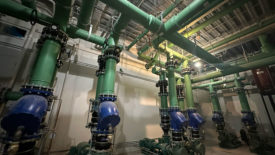Market Sectors
Guard on Compliance | Misty Guard
Changes to high-efficiency faucets and toilets aim to reduce water consumption.
Read More
Renewable Heating Design | John Siegenthaler
The anti-condensation function of piping assemblies
Biomass boiler protection.
July 1, 2024
Case Study
Pre-insulated PEXa pipe meets needs for outstanding energy efficiency and fast installation at new schools
High-performing district heating application facilitates a high-quality experience for students and teachers.
June 17, 2024
Ensuring corrosion protection beyond routine maintenance in fire sprinkler systems
Corrosion prevention is crucial for protecting lives and property.
June 12, 2024
Water-to-water heat pumps meet stringent efficiency requirements for new school facility
Reliability and sound performance were also strong considerations.
June 10, 2024
Guard on Compliance | Misty Guard
Dissecting IAPMO’s proposed code change monographs
The UPC and UMC received over 650 code change proposals.
June 3, 2024
Renewable Heating Design | John Siegenthaler
3-way diverter valves: Part 2
Real world valve applications.
May 30, 2024
Plumbing solutions making health care and senior facilities safer
Patient and resident safety on tap
May 22, 2024
University’s new sports complex benefits from hydronic heating and cooling system
Uponor PP-RCT offers a lightweight solution, promoting faster installation and jobsite safety.
May 20, 2024
Mixing valves play a key role in water safety
Thermal disinfection is the safest, most cost-effective method for controlling bacteria within plumbing systems.
May 16, 2024
Keep the info flowing with our eNewsletters!
Get the latest industry updates tailored your way.
JOIN TODAY!Copyright ©2024. All Rights Reserved BNP Media.
Design, CMS, Hosting & Web Development :: ePublishing











